Dynamic Range Compression and the Semantic Descriptor Aggressive
Abstract
Featured Application
Abstract
1. Introduction
1.1. Background
1.2. Research Aims
2. Qualitative Studies
2.1. Professional User Questionaire
2.2. Similarity Matrix
3. Preliminary Objective Tests
3.1. Choice of Compressor Time Constant Settings
3.2. Distortion Characteristics
4. Perceptual Listening Experiments
4.1. Listening Experiment 1 Method
4.1.1. Listening Experiment 1 Results and Discussion
4.1.2. Statistical Analysis of Experiment 1 Results
4.2. Listening Experiment 2 Method
4.2.1. Listening Experiment 2 Results and Discussion
4.2.2. Statistical Analysis of Experiment 2 Results
4.2.3. Textural Analysis of Descriptors Used by the Participants
5. Conclusions
Funding
Acknowledgments
Conflicts of Interest
References
- De Man, B. Towards a Better Understanding of Mix Engineering; Queen Mary University of London: London, UK, 2017. [Google Scholar]
- Pestana, P. Automatic Mixing Systems Using Adaptive Audio Effects. Ph.D. Thesis, Universidade Católica Portuguesa, Lisbon, Portugal, 2013. [Google Scholar]
- Moore, A. All Buttons in: An investigation into the use of the 1176 FET compressor in popular music production. J. Art Rec. Prod. 2012, 6. [Google Scholar]
- Ma, Z.; De Man, B.; Pestana, P.D.; Black, D.A.; Reiss, J.D. Intelligent multitrack dynamic range compression. J. Audio Eng. Soc. 2015, 63, 412–426. [Google Scholar] [CrossRef]
- Moffat, D.; Sandler, M. Adaptive ballistics control of dynamic range compression for percussive tracks. In Proceedings of the Audio Engineering Society Convention 145, New York, NY, USA, 17–20 October 2018. [Google Scholar]
- Moore, A.; Wakefield, J. An Investigation into the Relationship between the Subjective Descriptor Aggressive and the Universal Audio of the 1176 FET Compressor. In Proceedings of the Audio Engineering Society Convention 142, Berlin, Germany, 20–23 May 2017. [Google Scholar]
- Nielsen, S.H.; Lund, T. Level control in digital mastering. In Proceedings of the Audio Engineering Society Convention 107, Munich, Germany, 8–11 May 1999. [Google Scholar]
- Nielsen, S.H.; Lund, T. 0 dB FS+ Levels in Digital Mastering. In Proceedings of the Audio Engineering Society Convention 109, Los Angeles, CA, USA, 22–25 September 2000. [Google Scholar]
- Hjortkjær, J.; Walther-Hansen, M. Perceptual effects of dynamic range compression in popular music recordings. J. Audio Eng. Soc. 2014, 62, 37–41. [Google Scholar] [CrossRef]
- Taylor, R.W.; Martens, W.L. Hyper-compression in music production: Listener preferences on dynamic range reduction. In Proceedings of the Audio Engineering Society Convention 136, Berlin, Germany, 26–29 April 2014. [Google Scholar]
- Ronan, M.; Ward, N.; Sazdov, R.; Lee, H. The Perception of Hyper-Compression by Mastering Engineers. J. Audio Eng. Soc. 2017, 65, 613–621. [Google Scholar]
- Ronan, M.; Ward, N.; Sazdov, R. The Perception of Hyper-Compression by Untrained Listeners. In Proceedings of the Audio Engineering Society Conference: 60th International Conference: DREAMS (Dereverberation and Reverberation of Audio, Music, and Speech), Leuven, Belgium, 3–5 February 2016. [Google Scholar]
- Campbell, W.; Paterson, J.; van der Linde, I. Listener Preferences for Alternative Dynamic-Range-Compressed Audio Configurations. J. Audio Eng. Soc. 2017, 65, 540–551. [Google Scholar] [CrossRef]
- Wendl, M.; Lee, H. The Effect of Dynamic Range Compression on Perceived Loudness for Octave Bands of Pink Noise in Relation to Crest Factor. In Proceedings of the Audio Engineering Society Convention 138, Warsaw, Poland, 7–10 May 2015. [Google Scholar]
- Ronan, M.; Ward, N.; Sazdov, R. Investigating the Sound Quality Lexicon of Analogue Compression Using Category Analysis. In Proceedings of the Audio Engineering Society Convention 138, Warsaw, Poland, 7–10 May 2015. [Google Scholar]
- Stables, R.; De Man, B.; Enderby, S.; Reiss, J.D.; Fazekas, G.; Wilmering, T. Semantic description of timbral transformations in music production. In Proceedings of the 24th ACM international conference on Multimedia, Amsterdam, The Netherlands, 15–19 October 2016; pp. 337–341. [Google Scholar]
- Bromham, G.; Moffat, D.; Barthet, M.; Fazekas, G. The impact of compressor ballistics on the perceived style of music. In Proceedings of the Audio Engineering Society Convention 145, New York, NY, USA, 17–20 October 2018. [Google Scholar]
- Fenton, S.; Lee, H. A Perceptual Model of “Punch” Based on Weighted Transient Loudness. J. Audio Eng. Soc. 2019, 67, 429–439. [Google Scholar] [CrossRef]
- Dewey, C.; Wakefield, J. Elicitation and Quantitative Analysis of User Requirements for Audio Mixing Interface. In Proceedings of the Audio Engineering Society Convention 144, New York, NY, USA, 17–20 October 2018. [Google Scholar]
- Jillings, N.; Man, B.D.; Moffat, D.; Reiss, J.D. Web Audio Evaluation Tool: A Browser-Based Listening Test Environment; Queen Mary University of London: London, UK, 2015. [Google Scholar]
- DC8C Overview. Available online: https://klanghelm.com/contents/products/DC8C/DC8C.php (accessed on 10 January 2020).
- Snow, J.; Mann, M. Qualtrics Survey Software: Handbook for Research Professionals; Qualtrics Labs, Inc.: Provo, UT, USA, 2013. [Google Scholar]
- Ponemon, L.A.; Wendell, J.P. Judgmental versus random sampling in auditing: An experimental investigation. Auditing 1995, 14, 17. [Google Scholar]
- Moore, A. An Investigation into Non-Linear Sonic Signatures with a Focus on Dynamic Range Compression and the 1176 Fet Compressor; University of Huddersfield: Huddersfield, UK, 2017. [Google Scholar]
- Woodcock, J.S.; Davies, W.J.; Cox, T.J.; Melchior, F. Categorization of broadcast audio objects in complex auditory scenes. J. Audio Eng. Soc. 2016, 64, 380–394. [Google Scholar] [CrossRef]
- Berg, J.; Rumsey, F. Verification and Correlation of Attributes Used for Describing the Spatial Quality of Reproduced Sound. 2001. Available online: http://epubs.surrey.ac.uk/542/1/fulltext.pdf (accessed on 10 January 2020).
- Simurra Sr, I.; Queiroz, M. Pilot experiment on verbal attributes classification of orchestral timbres. In Proceedings of the Audio Engineering Society Convention 143, Berlin, Germany, 20–23 May 2017. [Google Scholar]
- Pearce, A.; Brookes, T.; Dewhirst, M.; Mason, R. Eliciting the most prominent perceived differences between microphones. J. Acoust. Soc. Am. 2016, 139, 2970–2981. [Google Scholar] [CrossRef] [PubMed]
- Zielinski, S.; Rumsey, F.; Bech, S. On Some Biases Encountered in Modern Audio Quality Listening Tests—A Review. J. Audio Eng. Soc. 2008, 56, 427–451. [Google Scholar]
- Bos, W.; Tarnai, C. Content analysis in empirical social research. Int. J. Educ. Res. 1999, 31, 659–671. [Google Scholar] [CrossRef]
- Waves Audio CLA Live at Mix LA Part 1/2—YouTube. Available online: https://www.youtube.com/watch?v=7heuq2lV3h4 (accessed on 10 January 2020).
- Ciletti, E.; Hill, D.; Wolff, P. Gain Control Devices, Side Chains, Audio Amplifiers. Available online: https://www.tangible-technology.com/dynamics/comp_lim_ec_dh_pw2.html (accessed on 10 January 2020).
- Union, I.T. Recommendation ITU-R BS. 1116-1; International Telecommunication Union: Geneva, Switzerland, 1997. [Google Scholar]
- Lartillot, O.; Toiviainen, P.; Eerola, T. MIRtoolbox 1.1 User’s Manual; Finnish Center of Excellence in interdisciplinary Music Research, University of Jyvaskyla: Jyvaskyla, Finland, 2008. [Google Scholar]
- Hummersone, C. Long Term Average Spectrum—File Exchange—MATLAB Central. Available online: https://uk.mathworks.com/matlabcentral/fileexchange/55212-long-term-average-spectrum (accessed on 10 January 2020).
- Bernays, M.; Traube, C. Verbal expression of piano timbre: Multidimensional semantic space of adjectival descriptors. In Proceedings of the Proceedings of the International Symposium on Performance Science (ISPS2011), Toronto, ON, Canada, 24–27 August 2011; European Association of Conservatoires (AEC): Utrecht, The Netherlands, 2011; pp. 299–304. [Google Scholar]
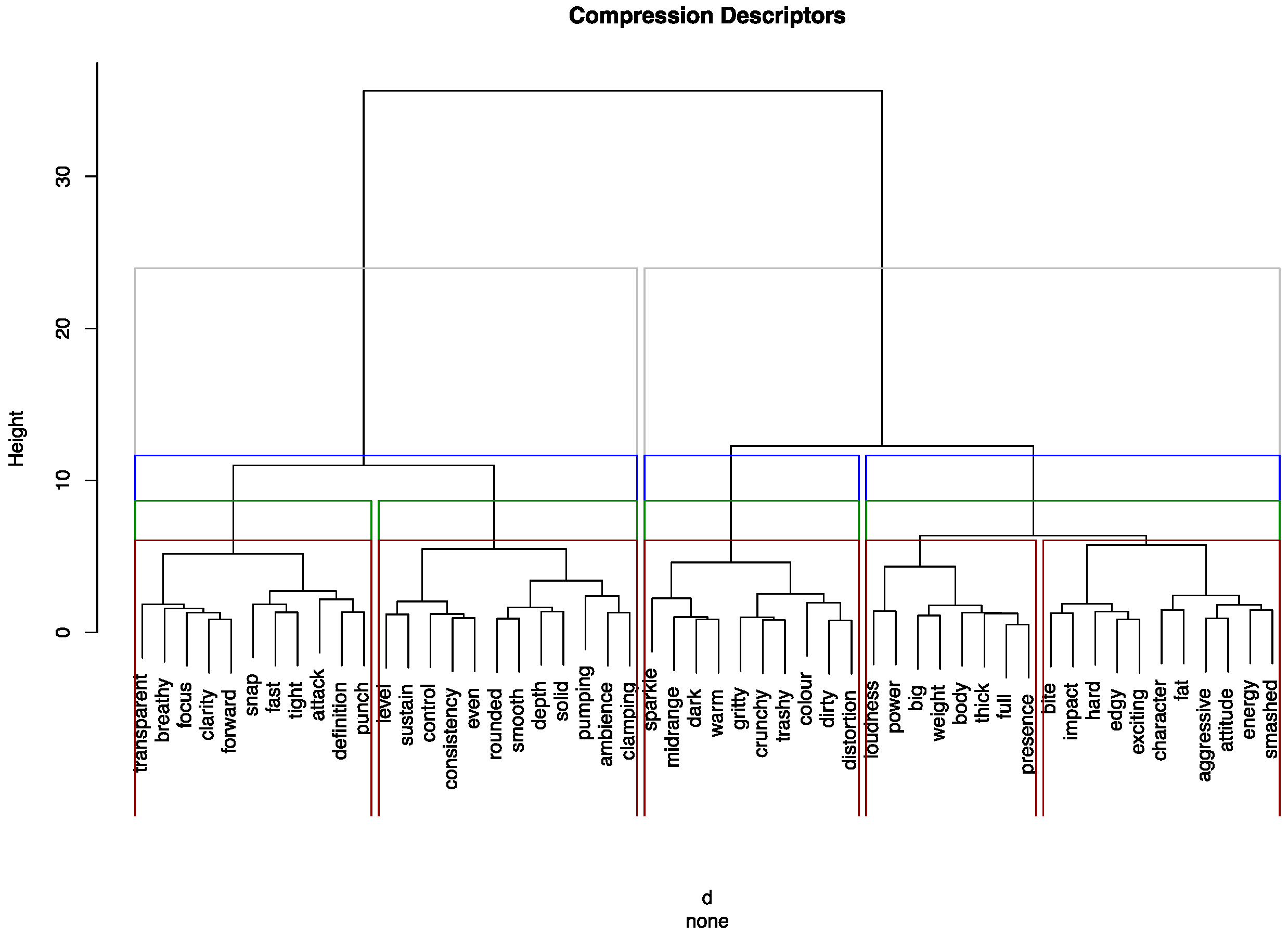
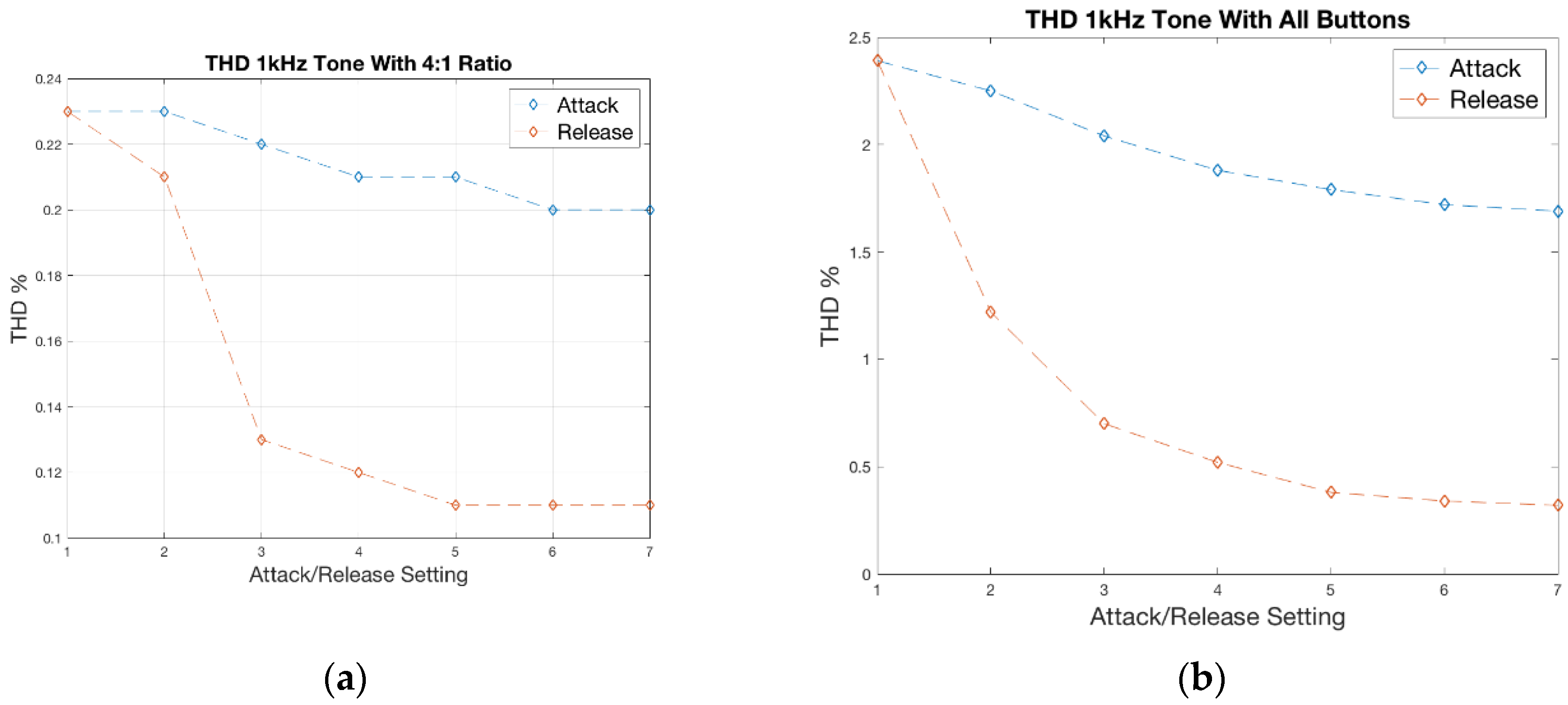
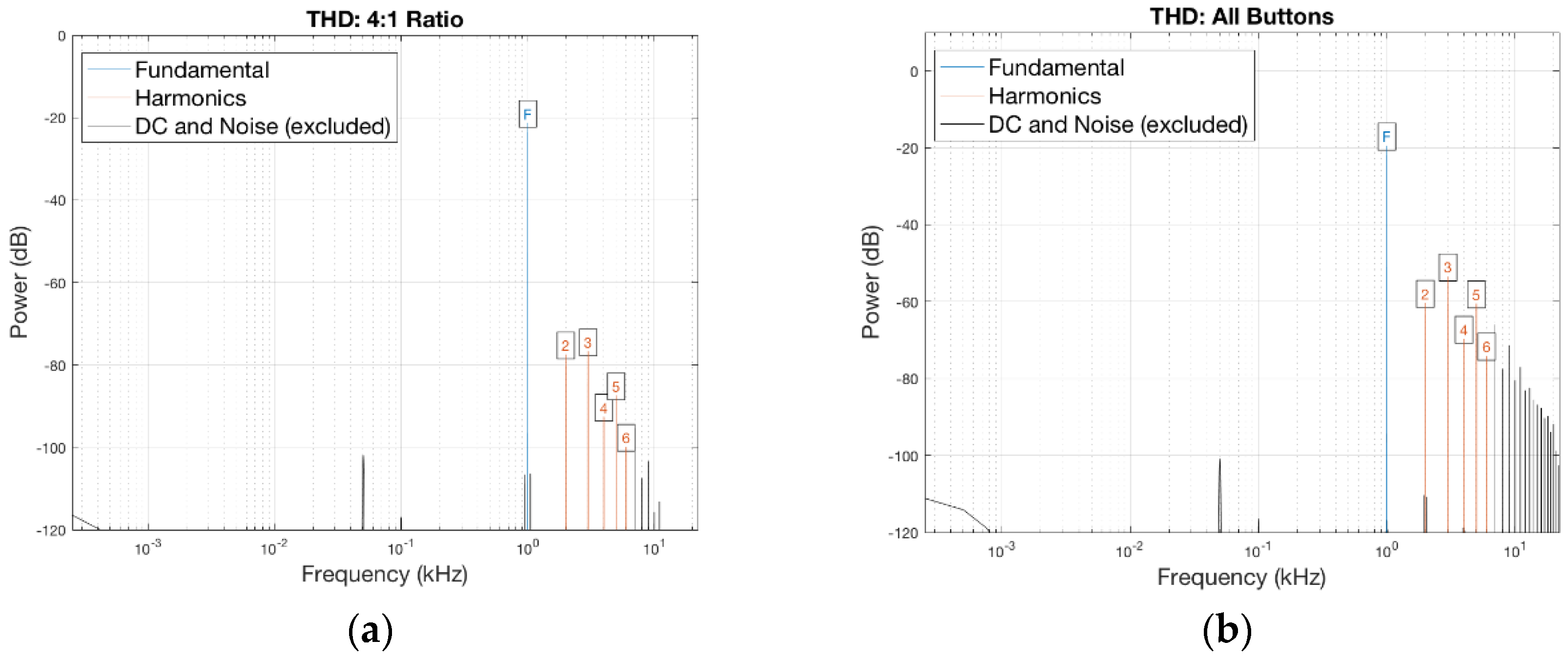
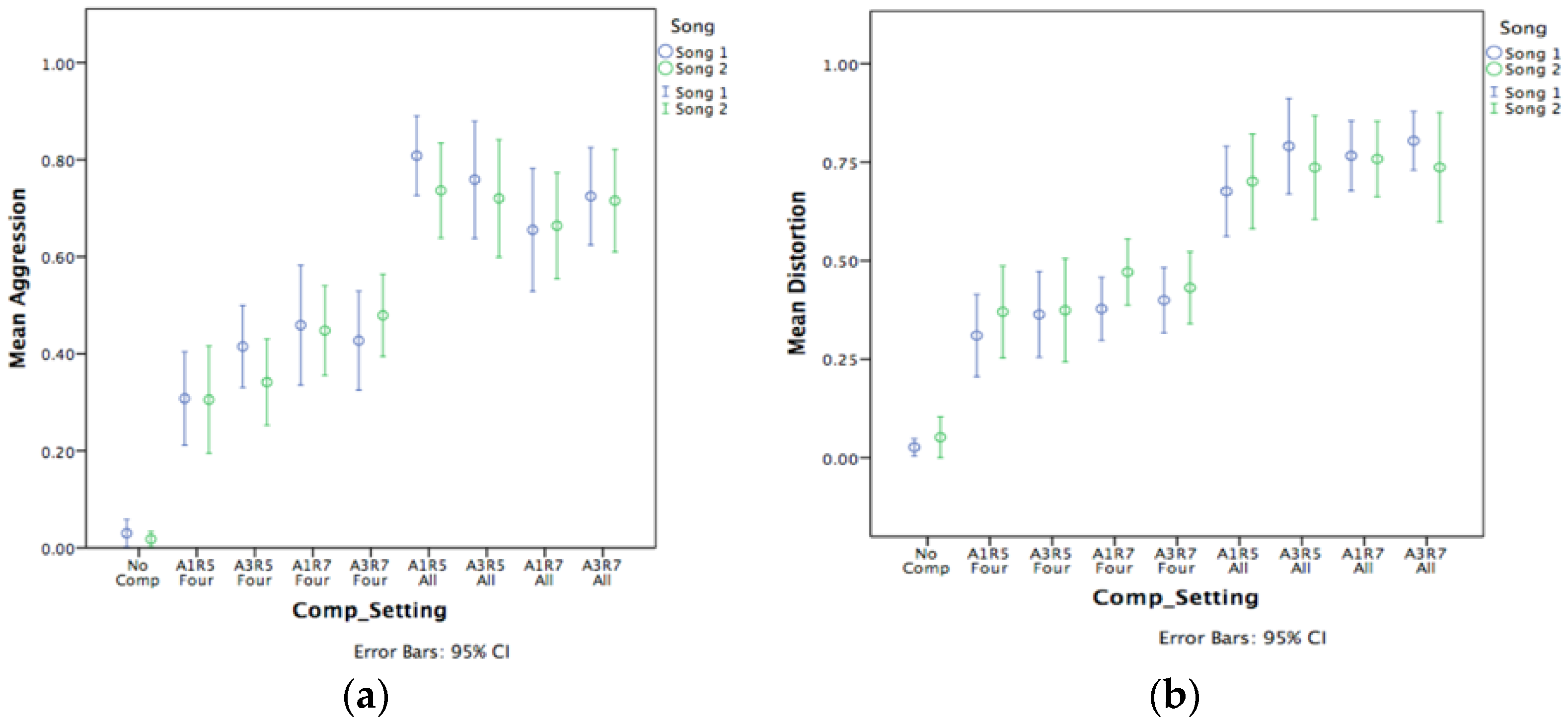
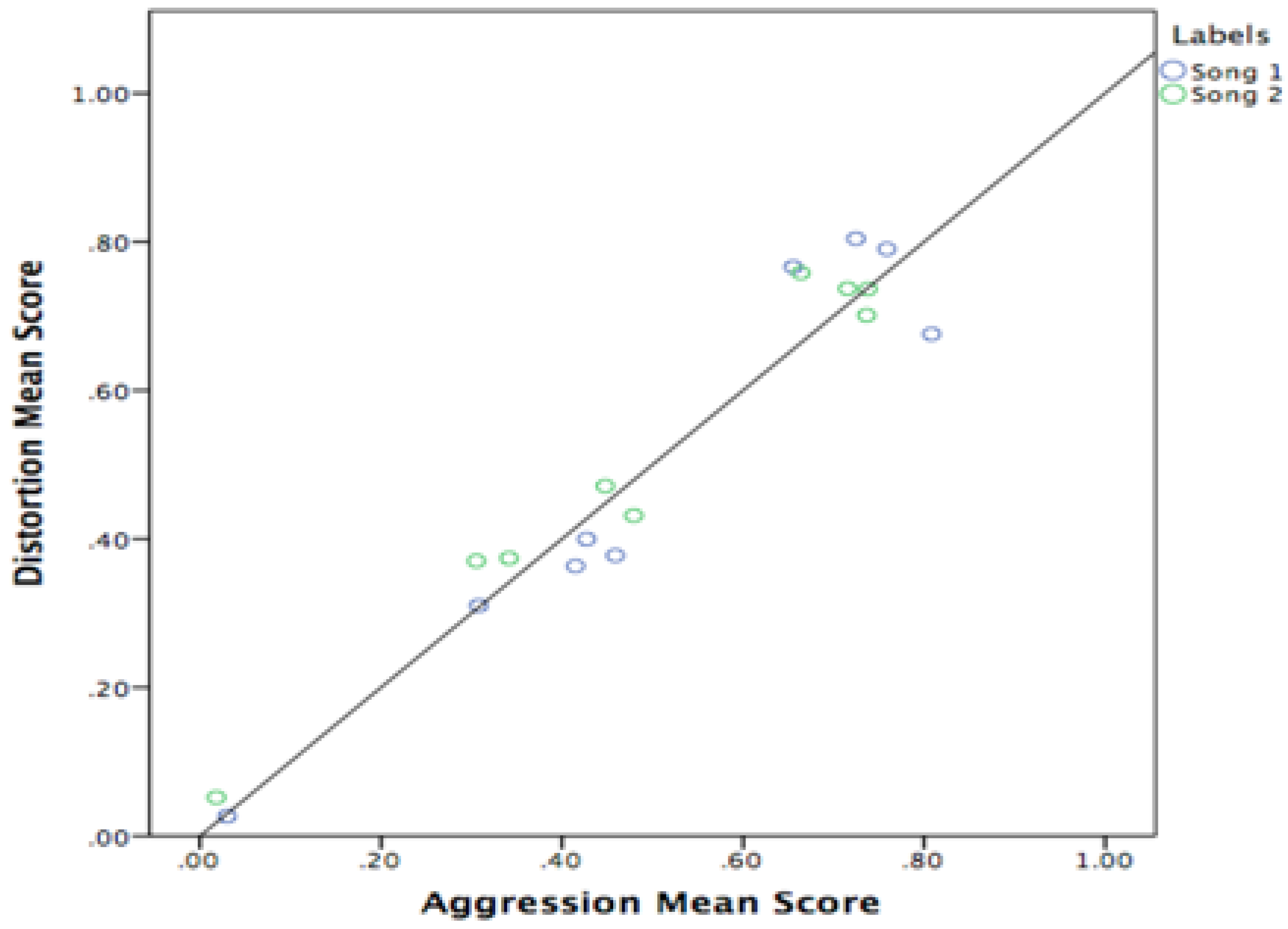
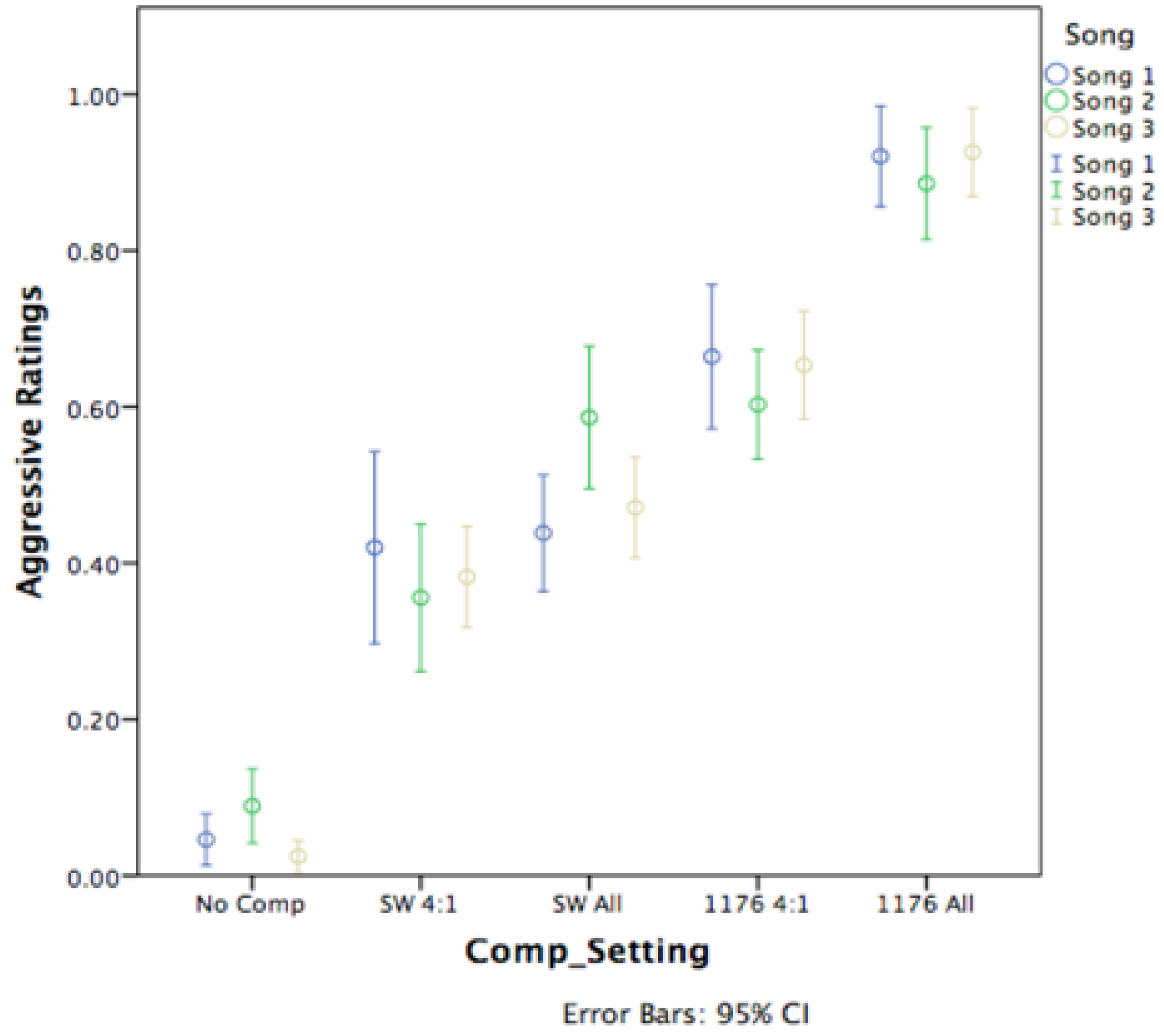
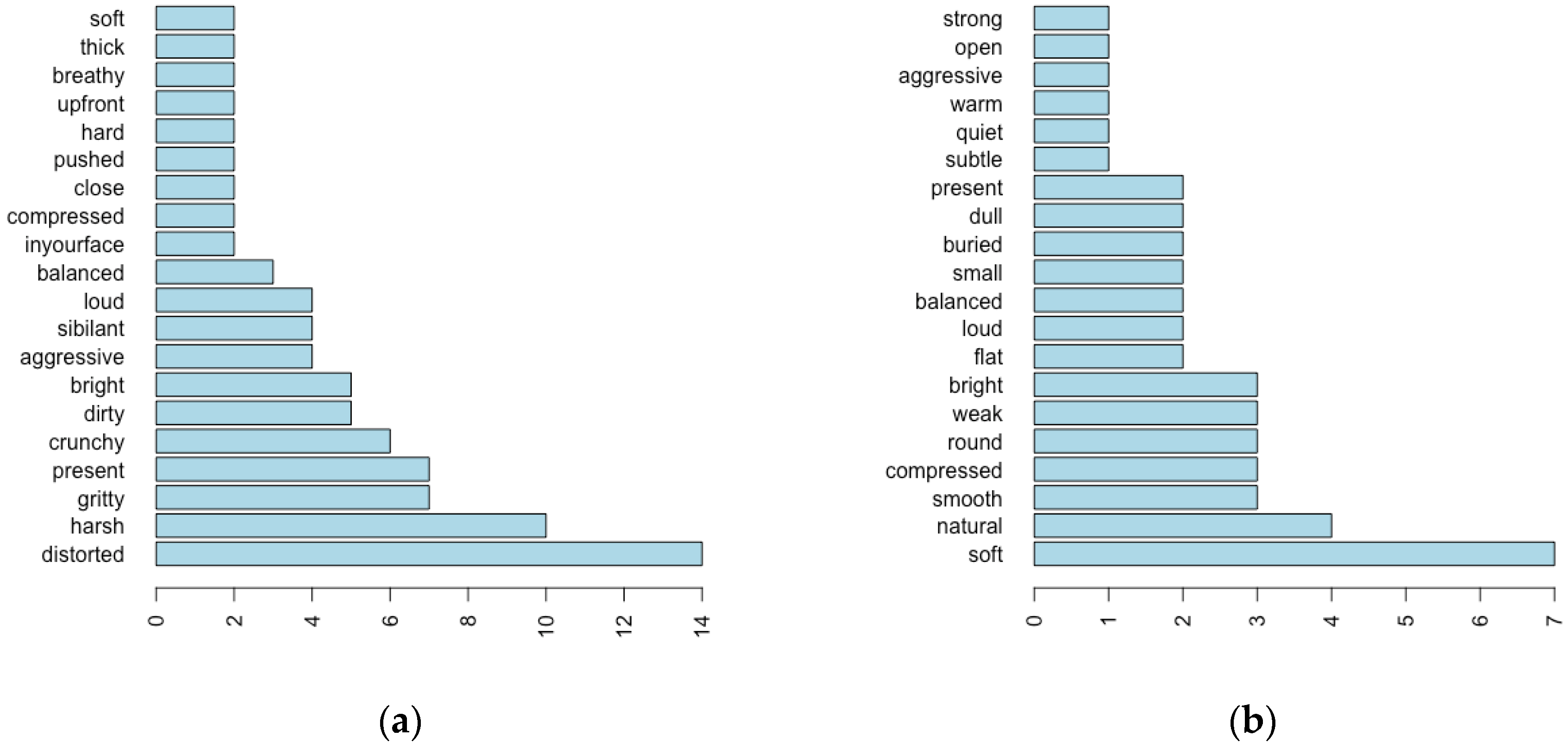

| Descriptor | Frequency of Occurrence |
|---|---|
| Aggressive | 21 |
| Pumping | 11 |
| Forward | 10 |
| Punch | 8 |
| Full | 8 |
| Midrange | 8 |
| Fast | 7 |
| Presence | 7 |
| Dirty | 6 |
| Gritty | 6 |
| Descriptor | Frequency of Occurrence |
|---|---|
| Aggressive | 6 |
| Gritty | 5 |
| Forward | 4 |
| Midrange | 4 |
| Presence | 4 |
| Full | 3 |
| Sparkly | 2 |
| Up Front | 2 |
| Pumping | 2 |
| Smooth | 2 |
| Setting | Release Setting Used | Attack Setting Used |
|---|---|---|
| 1 | 0% | 46.67% |
| 2 | 0% | 20% |
| 3 | 0% | 20% |
| 4 | 18.18% | 6.67% |
| 5 | 18.18% | 6.67% |
| 6 | 63.64% | 0% |
| 7 | 0% | 0% |
| 1–4 | 0% | 93.33% |
| 5–7 | 100% | 6.67% |
| Setting | THD |
|---|---|
| A3R7 All | 1.58% |
| A1R7 All | 1.51% |
| A3R5 All | 0.54% |
| A1R5 All | 0.50% |
| A3R7 4:1 | 0.25% |
| A1R7 4:1 | 0.24% |
| A3R5 4:1 | 0.17% |
| A1R5 4:1 | 0.16% |
| Roughness | Zero Crossing Rate | |||
|---|---|---|---|---|
| Setting | Song 1 | Song 2 | Song 1 | Song 2 |
| No Comp | 33.73 | 26.84 | 1887.92 | 1676.40 |
| A1R5 4:1 | 99.12 | 105.58 | 2909.15 | 2155.41 |
| A1R7 4:1 | 129.12 | 130.46 | 2915.28 | 2123.67 |
| A3R5 4:1 | 98.97 | 102.17 | 2579.37 | 2166.41 |
| A3R7 4:1 | 128.7 | 130.65 | 2484.85 | 2125.73 |
| A1R5All | 202.85 | 236.18 | 2966.41 | 2053.57 |
| A1R7All | 212.88 | 241.84 | 2850.03 | 2055.71 |
| A3R5All | 199.26 | 232.14 | 2881.21 | 2083.53 |
| A3R7All | 209.87 | 247.17 | 2953.82 | 2067.16 |
© 2020 by the author. Licensee MDPI, Basel, Switzerland. This article is an open access article distributed under the terms and conditions of the Creative Commons Attribution (CC BY) license (http://creativecommons.org/licenses/by/4.0/).
Share and Cite
Moore, A. Dynamic Range Compression and the Semantic Descriptor Aggressive. Appl. Sci. 2020, 10, 2350. https://doi.org/10.3390/app10072350
Moore A. Dynamic Range Compression and the Semantic Descriptor Aggressive. Applied Sciences. 2020; 10(7):2350. https://doi.org/10.3390/app10072350
Chicago/Turabian StyleMoore, Austin. 2020. "Dynamic Range Compression and the Semantic Descriptor Aggressive" Applied Sciences 10, no. 7: 2350. https://doi.org/10.3390/app10072350
APA StyleMoore, A. (2020). Dynamic Range Compression and the Semantic Descriptor Aggressive. Applied Sciences, 10(7), 2350. https://doi.org/10.3390/app10072350





